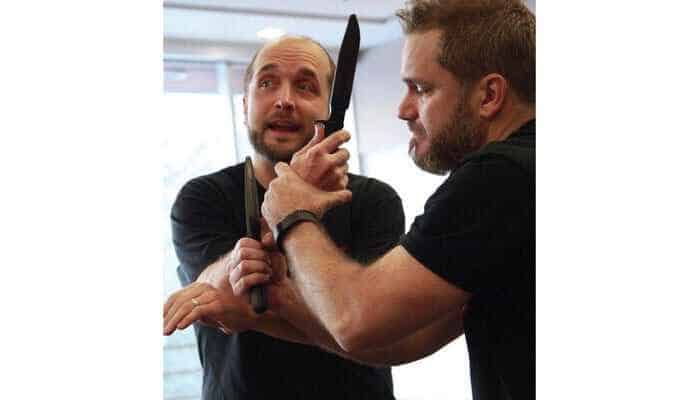When it comes to stagecraft, most actors will tell you that it’s easier to kiss someone than to kill them. Engaging in murder and mayhem doesn’t come naturally to performers. The same holds for playing dead. And while a staged barroom brawl may look effortless, it’s safe to assume that the actors needed inside information to pull it off. That’s where Jared Kirby comes in. Kirby is a co-founder of Art of Combat International, a collective of fight directors and trained combatants for stage and screen. Put simply, Kirby creates compelling fight scenes and prepares actors for a character’s final exit.
“Action films are so common that people think the violent bits are easy,” says the New York City-based Kirby. More often than not, actors and directors don’t take the time to show the dying process, which in turn affects how an audience reacts to a scene. He, on the other hand, knows that to bleed out from a lower abdomen wound “takes forever” while a knife to a lung results in a relatively quick death (and less stage time for the victim).
An actor and fencing instructor who is trained in the sixteenth century Spanish school of swordsmanship known as la destreza, Kirby teaches combat in all of its infinite permutations. Yet it is his grounding as a scholar and practitioner of classical fencing that informs his film and theatrical work. Unlike modern fencing, which he likens to a game in which you hit your opponent before he hits you, the destreza tradition focuses on self-defense or the art of the duel (although no one actually gets stabbed). Over the centuries, the discipline evolved to incorporate many different kinds of arms: rapiers, small swords, sticks, and other weapons are all employed in addition to the French foil.
Because there is such an emphasis on verisimilitude in his school of fencing, Kirby finds that the violence in too many films and plays appear choreographed to the detriment of the production. But combat isn’t — or shouldn’t be — a dance. “You want the people in the audience to feel uncomfortable” says Kirby, who believes that violence should reveal character or advance plot rather than merely entertain or horrify. “If the people watching the production sit back in their seats, unaffected, you’re wasting their time.”
Fittingly, Kirby identifies as a pacifist. For a pacifist, he knows more about violence and its effect on human anatomy than most of us would wish to know. Ultimately, such knowledge is in the service of choices that determine how an actor will play a scene or take his leave from it. About that knife through the lung, for example: Does it go in through the chest or pierce the diaphragm? If it’s the former, the actor-victim will have to imagine what it feels like to have a collapsed lung, “Look,” says Kirby, “I don’t revel in this stuff, really, I don’t, but you need to know these things to create an effective fight scene.”
Stephen Solow, a 24-year old Hamptons resident, agrees. For the last five years, Solow has been training in swordsmanship and stage combat with Kirby and his colleagues. A member of Art of Combat International, he’s had bit parts in small theatrical productions and played a thug in B.P.M., a short film whose combat scenes Kirby coordinated. “We spent days rehearsing,” says Solow of his few seconds of screen time. “I grew up watching Star Wars and The Princess Bride and Lord of the Rings and wished I could do those action scenes. And now, thanks to Jared, I’m a ‘combative’ who can also act.”









![Join us May 6th at The Harmonie Club for the Spring Salon Luncheon, a beautiful gathering in support of a truly meaningful cause. Together, we’ll raise critical funds and awareness for @campgoodgriefeeh—@eastendhospice’s summer bereavement camp helping children and teens navigate loss with compassion, connection, and healing. [link in bio]](https://hamptonsrealestateshowcase.com/wp-content/uploads/sb-instagram-feed-images/491527001_18506092897030135_3117653411609489602_nfull.webp)
![Welcome to this exquisite custom-built home in the prestigious Quogue South estate section, just moments from Dune Road and some of the world’s most breathtaking ocean beaches. Completed in 2024, this expansive shingle-style residence offers 6 beds, 7 full and 2 half baths, a separate legal guest cottage, heated gunite saltwater pool with spa, all set on a beautifully manicured 0.74± acre lot. Represented by @lauren.b.ehlers of @brownharrisstevens. [link in bio]](https://hamptonsrealestateshowcase.com/wp-content/uploads/sb-instagram-feed-images/491516869_18505931593030135_4655757731678000577_nfull.webp)
![Discover 11 Oyster Shores, a unique marriage of thoughtful design, uncompromised execution and meticulous craftsmanship expressed across nearly 6,000± sq. ft. of highly curated living space. Brought to life under the watchful eye of Blake Watkins, the visionary behind WDD, the project is a refreshing departure from the ordinary. Represented by @nobleblack1 of @douglaselliman. [link in bio]](https://hamptonsrealestateshowcase.com/wp-content/uploads/sb-instagram-feed-images/491440257_18505740808030135_9064730571228880657_nfull.webp)
![Reserve your ad space now in the Memorial Day “Summer Kick-Off” Issue of #HRES! 🍋 Be seen by high-end buyers and sellers across the Hamptons, Manhattan, and South Florida—just in time for the start of the season. Secure your spot today and make waves this summer 🌊☀️ [link in bio]](https://hamptonsrealestateshowcase.com/wp-content/uploads/sb-instagram-feed-images/491441694_18505573426030135_4475989184561040528_nfull.webp)

![Tuesday, April 15, was Tax Day for most, but for someone in Palm Beach, it was closing day! The nearly 8,00± sq. ft. Mediterranean-style residence at 240 N Ocean Boulevard, with direct ocean views and a private, 100-foot beach parcel, closed at exactly $26,670,750. The seller was represented by Jack Rooney of @douglaselliman and Elizabeth DeWoody of @compass while Dana Koch of @thecorcorangroup brought the buyer. [link in bio]](https://hamptonsrealestateshowcase.com/wp-content/uploads/sb-instagram-feed-images/491445351_18505056166030135_4907944420436119099_nfull.webp)
![Previously featured on our 2024 Columbus Day issue cover, 74 Meeting House Road has officially sold! This stunning new construction in Westhampton Beach offers the perfect blend of thoughtful design and timeless style. Congratulations to @kimberlycammarata of @douglaselliman who held the listing! [link in bio]](https://hamptonsrealestateshowcase.com/wp-content/uploads/sb-instagram-feed-images/491441951_18504901357030135_2664904795600183799_nfull.webp)
![Located South of the highway in Southampton this 4 bedroom, 5.5 bath multi-story property, offers extensive exterior architectural detail throughout. 60 Middle Pond Road offers breathtaking views and tranquil living, nestled along the serene shores of Middle Pond and Shinnecock bay. Represented by @terrythompsonrealtor @douglaselliman. [link in bio]](https://hamptonsrealestateshowcase.com/wp-content/uploads/sb-instagram-feed-images/491451873_18504686110030135_5284427082339135969_nfull.webp)
